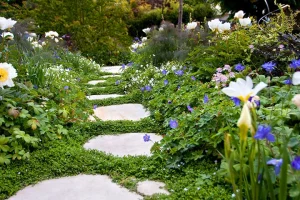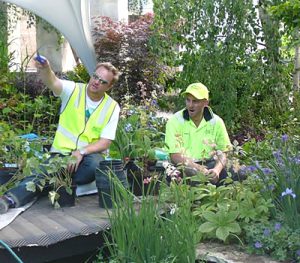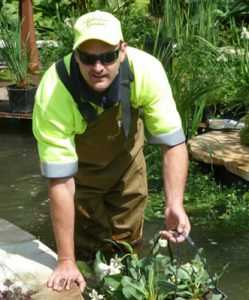After a few weeks in Europe with Lyn and Jonathon I feel back to my normal self. I have been home in Australia for a little while now but before I go on with my Chelsea Wash-up I want to say how overwhelming the generosity of spirit from everyone wishing their congratulations has been. Being involved in Chelsea for the last four years has been a truly wonderful experience and long after the garden is forgotten I will have memories that will live on with me forever.
It has been these conversations that have inspired me to do this Wash-up, and to set the record straight about a few things.
First: is it congratulations or commiserations? The answer is it is really both. No one goes to Chelsea hoping to achieve anything less than a gold medal. The Chelsea Flower Show is like the Olympics of our industry – if an athlete gets an opportunity to compete at the Olympics, they’re not going hoping for a bronze! Of course they will be proud of whatever they achieve, but certainly a sprinter couldn’t help but think to themselves, “Geez – another tenth of a second and that would have been a gold medal!” Even though I am immensely proud of what we achieved this year at Chelsea, I still feel a little like we lost the Grand Final by a kick. I guess we will always feel that way.
Second: Many people have told me that they can’t understand why the garden didn’t receive a gold medal. This is a lovely thing to hear, but I actually feel very comfortable with the judge’s decision. A Chelsea Show Garden is judged by no less than 12 different judges from different sectors of our industry; four of these judges mark their cards without the other judges present. There’s absolutely no chance of an error in scoring with all that correlation. It is also important to note that the overriding thing at Chelsea is that the plants take centre stage more than any other garden show in the world. If the garden isn’t perfect horticulturally then you won’t get a gold medal regardless of how it looks.

Every show garden receives feedback from the judges after the results have been announced. Our feedback centred on our tree specimens. The judges felt that our White Flowering Dogwood’s (Cornus florida) and Forest Pansy’s (Cercis canadensis) were not up to Chelsea standard, and that these cost us too many points. The Dogwood’s flowered two weeks too early and anyone who has seen a Dogwood after it has flowered will know how much they droop. The Forest Pansy’s were too thin; we knew this prior to judging and knew that they were a problem, but we were in a catch 22. If we removed the trees the garden would look too open, and we couldn’t replace them with another species because of the need to meet our own brief. So they had to stay. A few people have said that this seems really harsh, but I don’t feel that way because this is exactly why Chelsea is so good. If you get a gold medal you know you have got everything right, and well and truly earned it.
Third: Best in Show – how did it win? Every year there is a debate between those that love the Best in Show garden, and those that don’t. I wasn’t a big fan of The Daily Telegraph Garden by Cleve West myself until I heard the judge’s comments. I didn’t understand the huge granite columns and I couldn’t believe that I was seeing storm water pipes coming out of a wall again….but it was the plants that won the judges over. The planting design was deliberately open and rustic, and used plants in way that hasn’t been seen at Chelsea for a very long time. West used English Box as shrubs & not hedges; when was the last time anyone has seen English Box in a garden show that hasn’t been clipped to within an inch of its life? Love it or hate it, it was this boldness that the judges loved.
Fourth: The Irish Sky Garden comes up a lot because I mentioned it a fair bit during the build, as I described it as his to lose. Diarmuid Gavin has a habit of going over-the-top, and I think this is exactly what he did this year. The garden design idea was literally out of this world, but once all his grasses went in around the ponds, the public couldn’t see the majority of the garden from street level. The only way you could see the garden in its entirety was if you caught a lift on the pink pavilion, and were raised up into the sky by a crane. Part of the assessment is how the garden looks from the public viewing points, which could have made the difference for Gavin. Despite this, his use of topiary sphere’s gently bouncing up the hill towards a back drop of birches is the most beautifully made garden I have ever seen, and I think why he is so highly regarded around the world.
So that summarises the main topics that I wanted to clarify. Other points of interest for me at the show were the Principality of Monaco garden by Sarah Eberle for it’s clever design elements; the Cranbourne garden by Jim Fogarty was horticulturally incredible; and the Laurent-Perrier Garden by Luciano Giubbilei was my pick for Best in Show. Giubbilei’s pavilion screens slowly turning in the wind was stunning, but the plants and planting design was amazing. Planted in a grid formation, six or seven different plants when repeated again and again and viewed from a distance looked as one, and then when viewed closer the subtleties of the different colours brought the whole garden alive.
I was blown away in 2008 when I first saw the quality of the planting at Chelsea and four years on my new found respect for plants has only strengthened. I’m going to start using my blog to explore & analyse the planting palettes that have and continue to inspire me. The first case study will be by one of my favourite designers – Tom Stuart-Smith – from his 2008 Chelsea garden. It is my hope that by studying planting design, I will give myself a great foundation so that one day if I make it back to Chelsea I will have a better chance of achieving that now elusive gold.
Stay tuned.
-Ian


